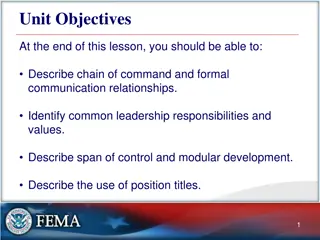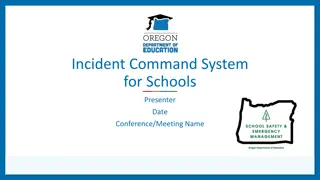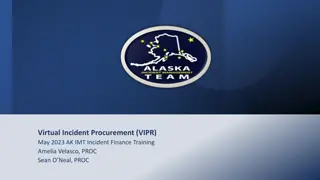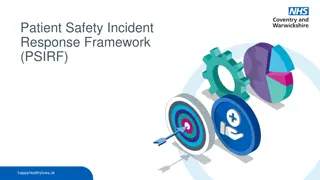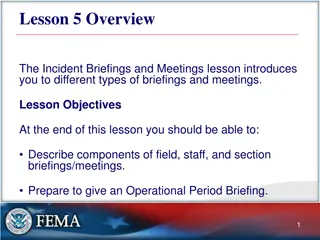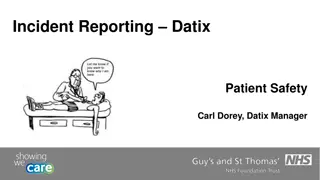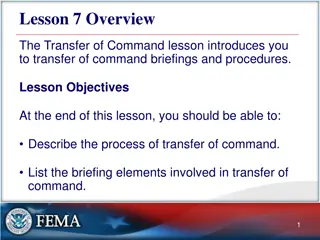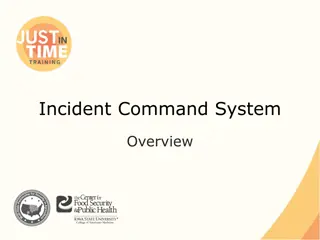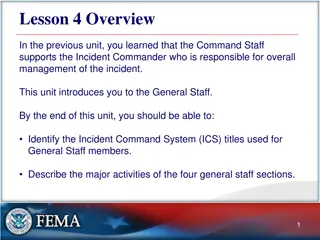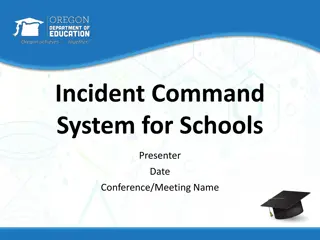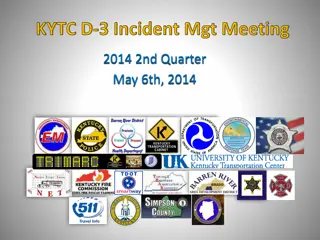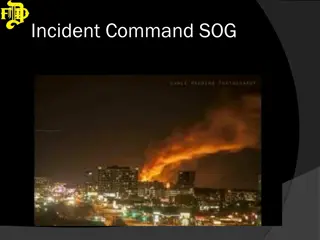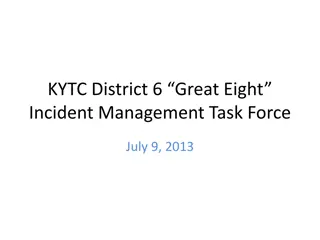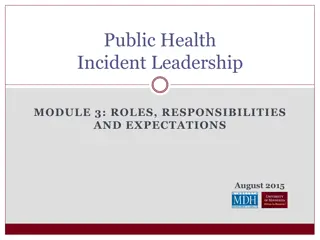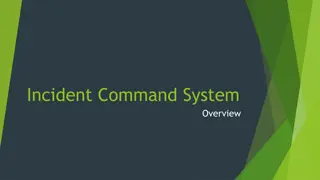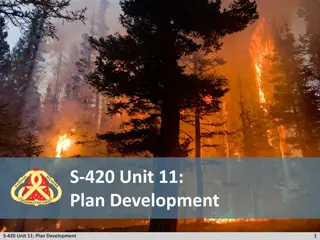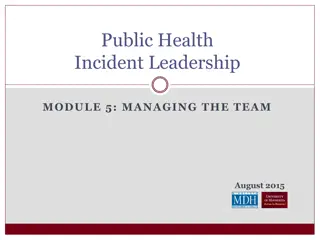Basic Incident Command System Overview
This lesson provides a summary of the Basic Incident Command System for Initial Response course content. It covers the NIMS framework, ICS management systems, incident command structure, unity of command, communication protocols, delegation of authority, and management by objectives. Understanding these principles is crucial for effective incident management and response.
Download Presentation

Please find below an Image/Link to download the presentation.
The content on the website is provided AS IS for your information and personal use only. It may not be sold, licensed, or shared on other websites without obtaining consent from the author.If you encounter any issues during the download, it is possible that the publisher has removed the file from their server.
You are allowed to download the files provided on this website for personal or commercial use, subject to the condition that they are used lawfully. All files are the property of their respective owners.
The content on the website is provided AS IS for your information and personal use only. It may not be sold, licensed, or shared on other websites without obtaining consent from the author.
E N D
Presentation Transcript
Lesson 9 Overview This lesson provides a brief summary of the Basic Incident Command System for Initial Response course content. After reviewing the summary information, you will receive instructions for taking the course Final Exam. 1
Lesson 1: Course Overview (NIMS & ICS Review) NIMS provides the Nation with a standardized framework for incident management. ICS, a part of NIMS, is a management system used to meet the demands of incidents large or small, planned or unplanned. The NIMS Management Characteristics: Common Terminology Modular Organization Management by Objectives Incident Action Planning Manageable Span of Control Incident Facilities and Locations Comprehensive Resource Management Integrated Communications Establishment and Transfer of Command Unified Command Chain of Command and Unity of Command Accountability Dispatch/Deployment Information and Intelligence Management 2
Lesson 2: Incident Command and Unified Command Chain of Command is the line of authority that flows down through the organizational structure. Unity of Command means that each individual will be assigned and report to only one supervisor. Unity of Command is different from Unified Command; Unified Command is established when no one jurisdiction, agency, or organization has primary authority, therefore there is no one clear Incident Commander. These multiple agencies work together to communicate and make command decisions. Communication during an incident may be formal or informal Formal communications must be used for work assignments, resource requests, and progress reports. Informal communication is used to exchange incident or event information only. 3
Lesson 2: Incident Command and Unified Command All levels of leadership on an incident should understand and practice the leadership principles, have a commitment to duty, and take actions that prioritize the safety of personnel. Clear communication is the responsibility of all responders in order to accomplish incident objectives. Incident Management Assessments may be conducted by leadership after an incident to help personnel process what happened and why. ICS utilizes a Modular Organization so that the organization can expand and contract as an incident grows and shrinks. This modular organization helps maintain an effective span of control. Manageable span of control with Modular Organization is accomplished by organizing resources into Teams, Divisions, Groups, Branches, or Sections. Leadership in each organizational level holds a unique title. The flexibility allowed for in ICS does is not override the importance of Common Terminology. Common Terminology must be used to maintain clear communication, whether formal or informal. 4
Lesson 3: Delegation of Authority and Management by Objectives Authority is the right or obligation to act on behalf of a department, agency, or jurisdiction. The scope of authority that an Incident Commander has is determined by existing laws, policies, and procedures. Additional authority may be delegated when necessary. Delegation of authority is the process of granting authority to an individual or agency to carry out specific functions during an incident. Delegation of authority does NOT relieve the granting entity of the responsibility for that function. Authority can be delegated; responsibility cannot. 5
Lesson 3: Delegation of Authority and Management by Objectives When needed, a delegation of authority should contain elements related to restrictions, external implications and considerations, and planning and communication processes. Authority is implemented by the Incident Commander through the management of objectives. Effective Incident Objectives should be SMART. Objectives are not tactics or strategies; they state what needs to be accomplished, not how to do it. Objectives are a part of the Incident Action Plan, which is completed each operational period and outlines incident-specific information. It is created through a process known as the Operational Period Planning Cycle (Planning P). Incident Command, as well as Command and General Staff, should also have a working knowledge of other preparedness plans, such as EOPs, SOGs, SOPs, and mutual aid agreements. 6
Lesson 4: Functional Areas and Positions The Incident Commander oversees the incident, sets incident objectives, and approves the IAP. Command Staff include the Public Information Officer, Safety Officer, and Liaison Officer. The Incident Commander also oversees four sections of the ICS organizational structure: Operations, Planning, Logistics, and Finance & Administration. Each of these sections is responsible for a different function during an incident; Sections are led by the General Staff who report to the Incident Commander. General Staff are titled as Section Chiefs. Operations directs and coordinates all incident tactical operations. 7
Lesson 4: Functional Areas and Positions Planning maintains resource and situation status, prepares the IAP and other documents, and looks beyond the current operational period to anticipate potential future problems or events. Logistics is responsible for all support requirements, including communications, facility supplies, medical needs, and food and drink for incident personnel. Finance/Administration provides administrative and financial support services. This includes handling claims related to property damage, injuries, and fatalities. ICS Forms help communicate and organize information between Command, Command Staff, General Staff, and other incident personnel. 8
Lesson 5: Incident Briefings and Meetings Different meetings and briefings are used during the Incident Action Planning Process to share information. Briefings should be concise and may occur at the staff, field, or section level. Information shared during a briefing includes the current situation and objectives, safety issues and emergency procedures, work tasks, facilities and work areas, communication protocols, expectations, resource acquisition procedures, work schedules, and questions or concerns. The Operational Period Briefing is led by the Incident Commander to present the IAP. Command and General Staff will also participate to share important information. 9
Lesson 6: Organizational Flexibility NIMS requires organizational standardization use of Common Terminology; however, ICS is still flexible due to its Modular Organization. Functions and positions within the organizational structure are activated and filled based on the needs and demand of an incident. The ICS organizational structure will expand and contract with the incident. Personnel may hold multiple titles within an incident's organizational structure, but the titles must keep consistent with NIMS titles. Titles may not be shortened or combined. Proper Resource Management is essential to maintaining an accurate and up-to-date picture of resource utilization and needs. Incidents are typed based on size and complexity. Incident types move from Type 5 as the least complex to Type 1 as the most complex. 10
Lesson 7: Transfer of Command Transfer of Command is the process of moving the responsibility for incident command from one Incident Commander to another Incident Commander or Unified Command. Transfer of Command should take place face-to-face when possible and include a complete briefing that captures essential information. The transfer of command briefing should include elements such as the situation status, incident objectives and priorities, current organization, resource information, incident communications plan, etc. A notification of the time and date that the transfer of command becomes effective should be communicated to all incident personnel. 11
Congratulations! You should now be able to demonstrate knowledge of how to manage an initial response to an incident. The course specifically discussed: Incident Command and Unified Command Delegation of Authority & Management by Objectives Functional Areas & Positions Incident Briefings and Meetings Organizational Flexibility Transfer of Command Application of ICS for Initial Response 12
IS-200.c Final Exam Instructions When the review is completed, follow these Final Exam instructions: 1. Take a few moments to review your Student Manual and identify any questions. 2. Make sure that you get all of your questions answered prior to beginning the final test. 3. When taking the test online Go to http://training.fema.gov/IS/crslist.asp and click on the link for IS-0200.c. Click on "Take Final Exam." Read each item carefully. Check your work before submitting your answers. 13
Certificate of Completion To receive a certificate of completion, you must take the multiple-choice Final Exam and score at least 75 percent on the test. Upon successful completion of the Final Exam, you will receive an e-mail message with a link to your electronic certification. 14
Course Evaluation Completing the course evaluation form is important. Your comments will be used to evaluate the effectiveness of this course and make changes for future versions. Please use the course evaluation forms provided by the organization sponsoring the course. 15


